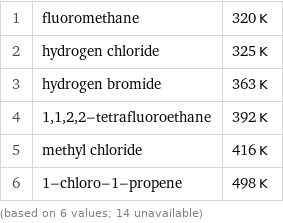Input interpretation

halogenated compounds | critical temperature
Summary

median | 377 K highest | 498 K (1-chloro-1-propene) lowest | 320 K (fluoromethane) distribution | | (based on 6 values; 14 unavailable)
Entities with missing values

acetyl fluoride | chlorocyclopentane | cupric fluoride | fluorocyclohexane | hydrofluoric acid | iodoacetonitrile | lithium bromide | lithium chloride | potassium chloride | potassium iodide | ... (total: 14)
Critical temperature rankings

1 | fluoromethane | 320 K 2 | hydrogen chloride | 325 K 3 | hydrogen bromide | 363 K 4 | 1, 1, 2, 2-tetrafluoroethane | 392 K 5 | methyl chloride | 416 K 6 | 1-chloro-1-propene | 498 K (based on 6 values; 14 unavailable)
Unit conversions for median critical temperature 377 K

104 °C (degrees Celsius)

220 °F (degrees Fahrenheit)

679 °R (degrees Rankine)

83 °Ré (degrees Réaumur)

62 °Rø (degrees Rømer)
Comparison for median critical temperature 377 K

23 K below hottest temperature of a Concorde nose tip (127 °C)

4 K above water boiling point (at standard pressure) (99.9839 °C)

84 K above conventional US room temperature (68 °F)
Corresponding quantities

Thermodynamic energy E from E = kT: | 33 meV (millielectronvolts)

Blackbody energy flux Φ from Φ = σT^4: | 1152 W/m^2 (watts per square meter)

Approximate luminous exitance from a planar blackbody radiator perpendicular to its surface: | 1.7×10^-15 lx (lux)
Nearest corresponding gas marks for median critical temperature 377 K (kelvins)

| temperature | usage stufe 1/2 | 100 °C | Germany (actual measurements may vary)